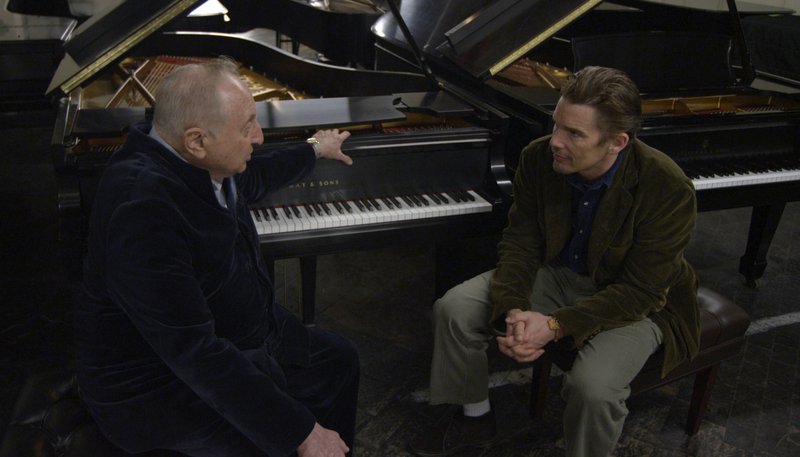Let us now praise Ethan Hawke. A little bit.
He has been on quite a roll the past couple of years, since the release of Richard Linklater's Before Midnight. Not only has he picked up a Best Supporting Actor nomination for his work in Linklater's Boyhood, he has been deservedly lauded for his understated and effective turns in the B-movies Getaway, The Purge and Predestination. He recently reunited with Gattaca director Andrew Niccol for the thoughtful drone warfare movie Good Kill.
Seymour: An Introduction
87 Cast: Documentary, with Seymour Bernstein, Ethan Hawke
Director: Ethan Hawke
Rating: PG, for some mild thematic elements
Running time: 84 minutes
There was a time when Hawke seemed to be one of the more annoying people on the planet. That was back when he was cheating on Uma Thurman and writing genuinely wretched novels. (I actually read them.) For every Hamlet or Training Day he gave us, he'd give us a Chelsea Walls or The Hottest State. Hawke was the '90s version of James Franco, the renaissance man/actor determined to let us all know how he was not defined by the roles he played onscreen. It all seemed a little graspy and insecure -- Hawke seemed desperate to convince us he was more than just another scruffy brooder with bedroom eyes. He was a Mensa member with mad nunchuck skills who served on literary-prize committees.
To tell the truth, I suspected that the real subject of Seymour: An Introduction might be the taste and sensitivity of its director, Hawke. And right there at the beginning of the film, we encounter Hawke confessing. "I've been struggling recently to find why it is that I do what I do," he tells a crowd of friends.
Yet while Hawke makes a couple of brief on-camera appearances in which he cannot help but be what he is, for the most part Seymour: An Introduction is a gentle yet insistent interrogation of a monkish master, an 88-year-old piano teacher named Seymour Bernstein who, in the grip of terrible stage fright compounded by existential dread, gave up a promising concert career to live in a one-room Manhattan apartment and teach piano.
Bernstein, a delightfully gentle soul, seems the antithesis of the drill sergeant jazz drum instructor played by J.K. Simmons in last year's Whiplash. He's patient with his students, taking them note by note through complicated passages, teasing out degrees of expressiveness through subtle calibrations of keyboard pressure, pedals and phrasing. He believes that without craft there can be no art -- that parents who don't make their children practice their instruments for at least an hour a day will wind up with "half-developed children" -- but he's no tyrant. He's more like Yoda, a gnomic and apparently celibate figure who has transcended his "personal self" to inhabit his "musical self."
Hawke's fascination with Bernstein began when the actor met him by chance at a dinner party, where they discussed Hawke's bouts with stage fright. Bernstein subsequently became a kind of guru to the actor, helping him to contain his ego, to make it subservient to his art.
"The social world is unpredictable," Bernstein tells him. "Art is predictable."
Well maybe, if you play the correct notes in the correct time with the proper feeling. Anyway, Bernstein seems incapable of playing any way but beautifully, with great sensitivity. We watch him rehearsing for a comeback concert Hawke has arranged for him to play at Carnegie Hall -- he seems made of music.
Still, as sweet-natured a film as this is, there are a couple of groan-inducing moments. First of all, the title, an allusion to a rather confusing 1959 J.D. Salinger story, "Seymour -- An Introduction," about Seymour Glass, a literary prodigy who committed suicide. Seymour's story is related in stream-of-consciousness style by his brother Buddy, and while there are those who consider Seymour Glass a kind of surrogate for Salinger, the allusion seems to have more to do with Hawke letting us know he's familiar with Salinger's titles than any real resonance with Bernstein's story.
And near the end the movie stumbles when, as Bernstein plays Chopin, we watch a montage of varied musicians -- chanting monks, African tribesmen, Mahalia Jackson -- in ecstatic performance. It overreaches, in the manner of Ernie, the pianist who -- in The Catcher in the Rye -- put in "all these dumb, show-offy ripples in the high notes, and a lot of other very tricky stuff."
Ernie's filigreed playing moves Holden Caulfield to "swear to God, if I were a piano player or an actor or something and all those dopes thought I was terrific, I'd hate it. I wouldn't even want them to clap for me. People always clap for the wrong things. If I were a piano player, I'd play it in the ... closet."
I suspect Bernstein would agree that people always clap for the wrong things. Maybe Hawke is figuring that out.
Email:
pmartin@arkansasonline.com
www.blooddirtangels.com
MovieStyle on 06/19/2015
